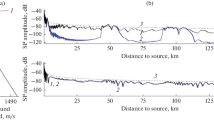Abstract—
The methods of direction finding for an immobile point source have been analyzed to obtain initial data for constructing acoustic distance measuring and tomography algorithms as applied to the deep sea. It is found that, to obtain reliable bearing estimates in the near- and far-field acoustic illumination zones (NFAIZ and FFAIZ), both in summer and in winter, it is sufficient to use the values of effective phase velocity (EPV) or effective group velocity (EGV) of sound, which are close to the measured speed of sound in water. However, in the shadow zone (SZ) under summer conditions, the effective velocities differ significantly from the speed of sound in water, and their values depend on distance, complicating additionally the solution of this problem. Therefore, to estimate the EPV and EGV, one must have information about the distance to the source. It is shown that application of vertically oriented antennas makes it possible to estimate the distance in the SZ and calculate independently the EPV and EGV values for each distance, which is necessary for direction finding. Thus, under summer conditions, conventional signal direction finding is performed in acoustic illumination zones, whereas in the SZ, in the case of simultaneous application of horizontal and vertical antennas, one must previously determine the distance to the source for calculating the bearing. The shadow zone is abscent in winter; thus, to phase a horizontal antenna on almost all distances, one can use the average speed of sound in water, but the antenna range must be determined.













Similar content being viewed by others
REFERENCES
W. Munk and C. Wunsh, “Ocean acoustic tomography: Rays and modes,” Rev. Geophys. Space Phys. 21 (4), 777 (1983). https://doi.org/10.1029/RG021i004p00777
Yu. N. Morgunov, “The acoustic underwater rangefinding peculiarities in the Sea of Japan winter hydrological conditions,” Podvodnye Issled. Robototekh., No. 1 (23), 57–61 (2017) [in Russian]. http://imtp-journal.com/issues/1-23-2017.html
V. M. Kuz’kin and S. A. Pereselkov, Interferometric Diagnostics of Hydrodynamic Disturbances of the Shallow Sea (Lenand, Moscow, 2019) [in Russian].
A. B. Baggeroer, “Why did applications of MFP fail, or did we not understand how to apply MFP?” Proc. 1st Int. Conf. and Exhibition on Underwater Acoustics (UACE2013), Ed. by J.S. Papadakis and I. Bjørnø (Corfu Island, Greece, 2013), pp. 41–49.
A. G. Sazontov and A. I. Malekhanov, “Matched field signal processing in underwater sound channels (Review),” Acoust. Phys. 61 (2), 213–230 (2015). https://doi.org/10.1134/S1063771015020128
G. N. Kuznetsov, V. M. Kuz’kin, S. A. Pereselkov, and D. Yu. Prosovetskiy, “Wave method for estimating the sound source depth in an oceanic waveguide,” Phys. Wave Phenom. 24 (4), 310–316 (2016). https://doi.org/10.3103/S1541308X16040129
G. N. Kuznetsov, “Problems in estimating the reduced noise of moving objects in shallow seas,” Proc. All-Russian Sci.-Tech. Conf. “Metrology of Hydroacoustic Measurements” (Mendeleevo, Russia, September 25–27, 2013) (State Sci. Centre RAS, Mendeleevo, 2013), Vol. 1, pp. 57–74 [in Russian].
G. N. Kuznetsov and O. V. Lebedev, “The possibility of using the equivalent plane wave model to increase the efficiency of taking bearings of low-frequency signals in shallow water,” Acoust. Phys. 58 (5), 575–585 (2012). https://doi.org/10.1134/S1063771012030098
L. M. Brekhovskikh and Yu. P. Lysanov, Theoretical Foundations of Ocean Acoustics (Nauka, Moscow, 2007) [in Russian].
S. P. Aksenov and G. N. Kuznetsov, “Estimating the range to the source in the deep sea using the spatial frequency responses of the interference invariant and effective phase and group velocities,” Acoust. Phys. 67 (6), 597–609 (2021). https://doi.org/10.1134/S1063771021060014
S. P. Aksenov and G. N. Kuznetsov, “Amplitude and phase structure of a low-frequency hydroacoustic field in the deep ocean,” Acoust. Phys. 67 (5), 474–485 (2021). https://doi.org/10.1134/S1063771021040011
Wave Propagation and Underwater Acoustics, Ed. by J. B. Keller and J. S. Papadakis (Springer-Verlag, Berlin–Heidelberg, 1977).
M. A. Ainslie, M. N. Packman, and C. H. Harrison, “Fast and explicit Wentzel–Kramers–Brillouin mode sum for the bottom-interacting field, including leaky modes,” J. Acoust. Soc. Am. 103 (4), 1804–1812 (1998). https://doi.org/10.1121/1.421333
R. J. Urick, Principles of Underwater Sound (McGraw-Hill, New York, 1975).
Funding
This study was supported by the program “Acoustics of Shallow Sea, Nonlinear Acoustic Diagnostics, Nonlinear Dynamics of Waves” (state registration number AAAA-A18-118021390174-1).
Author information
Authors and Affiliations
Corresponding author
Ethics declarations
The authors declare that they have no conflicts of interest.
Additional information
Translated by Yu. Sin’kov
Publisher’s Note.
Allerton Press remains neutral with regard to jurisdictional claims in published maps and institutional affiliations.
About this article
Cite this article
Aksenov, S.P., Kuznetsov, G.N. Physical Problems of Direction Finding in the Deep Sea. Phys. Wave Phen. 31, 383–395 (2023). https://doi.org/10.3103/S1541308X2306002X
Received:
Revised:
Accepted:
Published:
Issue Date:
DOI: https://doi.org/10.3103/S1541308X2306002X



